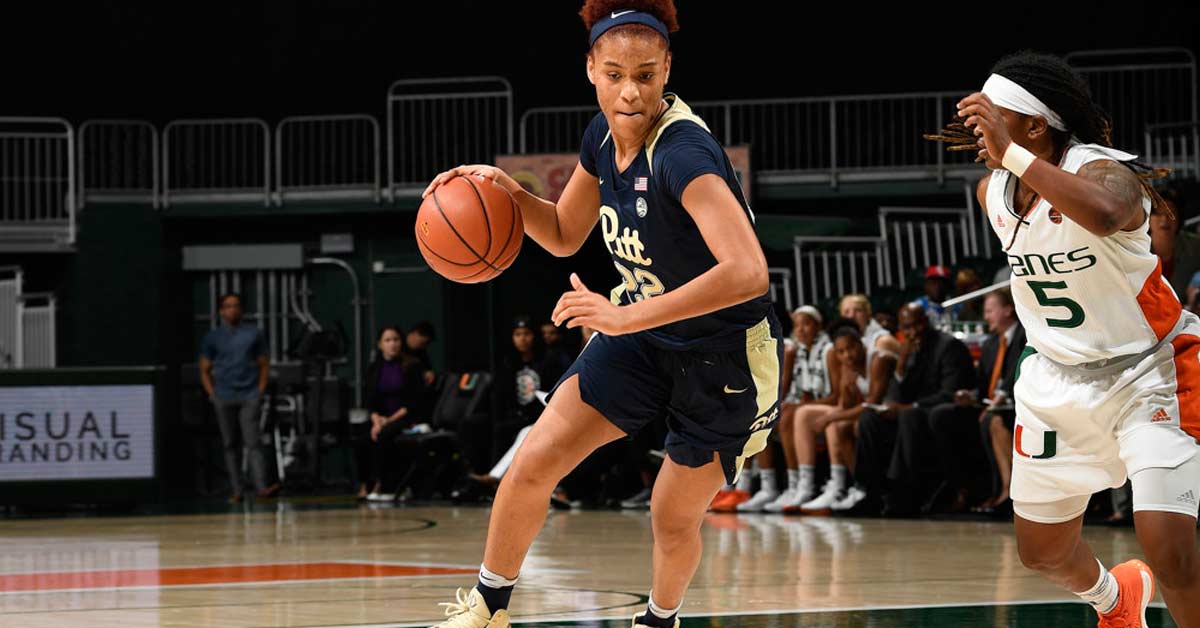The sports science team is important for athletic performance because it can take all the different streams of data and put them together to tell a story. At Pitt, we split our data into four separate categories: workload (Catapult), screening (Nordbord, GroinBar, force plates), readiness (questionnaires, contact grid, sleep tracking), and performance (force plates, GymAware). When sitting in performance team meetings, members of the Sports Science Department are able to make sense of what we think we know in light of what is actually happening on the field of play.
Ultimately, the sports science team integrates technology in an effort to improve training and impact decision-making. Data drives conversations; conversations drive decisions.
Ultimately, the sport science team integrates technology to improve training and impact decision-making. Data drives conversations, and conversations drive decisions, says @CoachStephMock. Share on XWhy collect all this data?
- To answer questions.
- To ask better questions.
- To discover new questions.
“The more you know, the more you know what you don’t know.” – Richard Feynman
Answering, Asking, and Discovering Questions
When the sports scientist/strength and conditioning coach is collecting all this data, it is easy for coaches to be overwhelmed. We try to simplify it for them by inserting the data into a feedback loop as seen below:
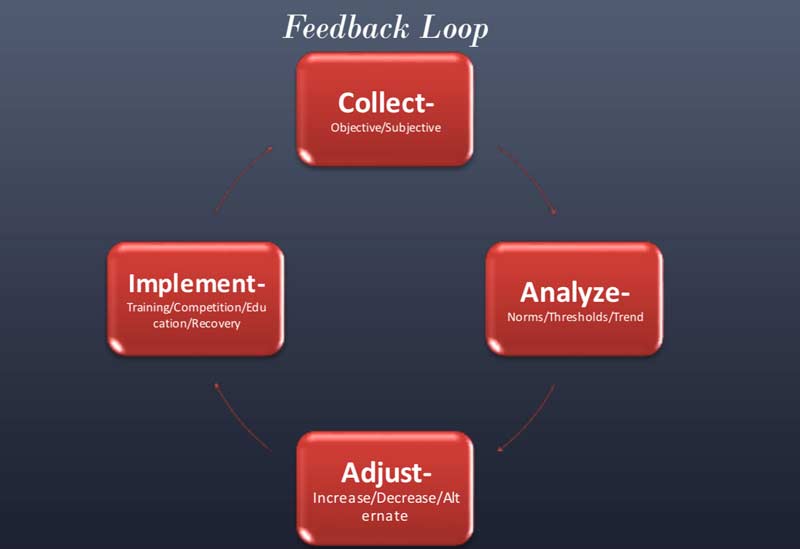
From this point forward, it is very important to define what the sports scientist’s key role is within the sports performance team.
What it is—Important unit of the interdisciplinary team, with a separate area of responsibilities that arose out of necessity to manage the data and its platforms. Responsibilities include (but are not limited to):
- Data collection, management, and analysis.
- Athlete assessment/profiling.
- Developing new practices of monitoring and adjusting training.
This position ultimately needs someone with time, competence, and interest.
What it isn’t—An avenue to tell coaches/staffs what to do, a desk jockey, or a fad.
A great sports scientist understands the physiology of training at a high level and makes their systems repeatable, not reliant on the same person to operate (so anyone can take over). Share on XA great sports scientist understands the physiology of training at a high level and makes their systems repeatable, not reliant on the same person to operate (so anyone can take over).
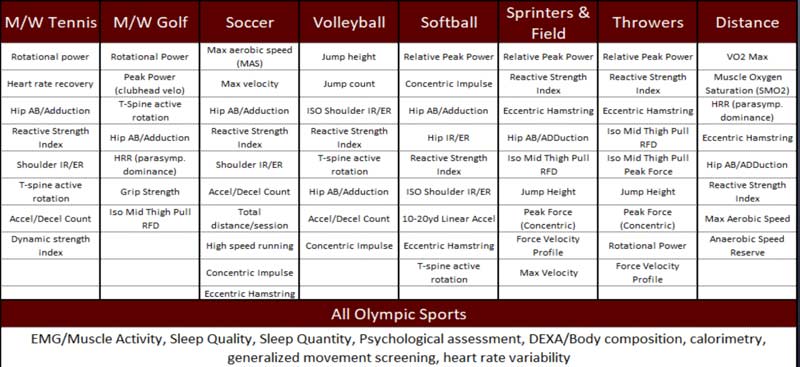
My Road to Now
I am now at my third university and utilize my past experiences when it comes to creating a successful Sports Science Department. Each environment has had its unique challenges and opportunities that have allowed me to tease out what is and is not important.
Stop #1—Clemson University (2013–2018)
- Advantages: Large operating budget and sizeable technology inventory.
- Challenges: Vast amount of data collected with varying degrees of importance.
- Successes: One of the first adopters of building an applied Sports Science Department.
Stop #2—Mississippi State University (2018–2021)
- Advantages: Organizational freedom to implement sports science practices.
- Challenges: Limited operating budget, no existing department upon arrival.
- Successes: Created partnerships with engineering and academia and instituted athlete engineering interns.
Stop #3—University of Pittsburgh (2021–present)
- Advantages: Effective operating budget and multiple partnerships.
- Neuromuscular Research Lab
- Sports Science Master’s Program
- Innovation Institute
- Pitt IT
- Challenges: No centralization of a true Sports Science Department upon arrival.
- Successes: Creation of Director of Sports Science position and investment from administration to see the department grow:
- Athlete Management System (AMS)
- New Performance Facility and Sports Science Lab (Fall 2024)
- Creation of the Sports Science ScD program (2023)
Based on these three different stops, I have had exposure to all levels of technology and the implementation of these tools. The goal at this point is to live in the high value quadrants, most notably the high value/low burden. This is where you will get optimal investment for maximal return.
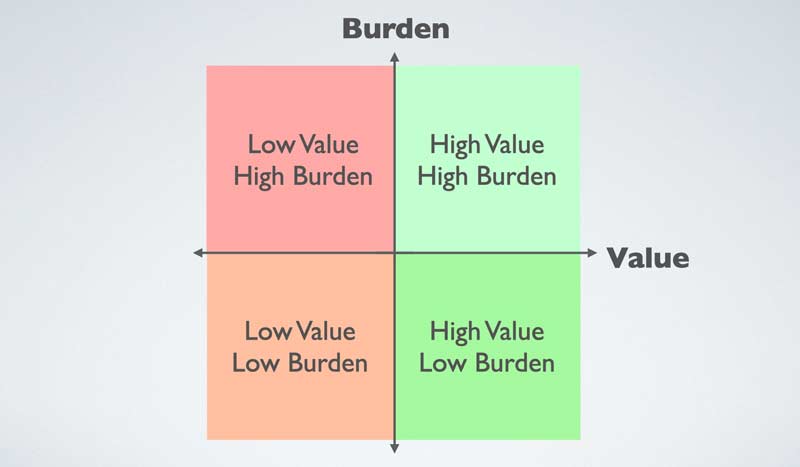
Figure 3. Burden/Value quadrants, adapted from Jo Clubb, Global Performance Insights.
When looking at a road map, I like to break it down into a three-year process with specific goals and objectives to be accomplished in each year.
Year One: Break Ground and Lay the Foundation
We are currently in year one. When stepping into this role, it was important for me to assess and analyze many things: what had already been put in place, what was working, what wasn’t working, and what I can do in the first 90 days to begin to create a blueprint of what I want to implement.
Goals/Objectives:
- Educate sport coaches and administration.
- Develop Sports Science Master’s students’ curriculum.
- Track athlete engagement (starting point).
- Introduce the Sports Science Playbook.
- Sports Science Open House.
Let’s first talk about staffing. Currently, we are lucky to have a partnership with our Sports Science Master’s program through our School of Health and Rehabilitation Sciences as well as our Neuromuscular Research Laboratory. This partnership was forged through open communication and mutual benefits to both parties involved.
Our Sports Science Master’s students take on two different curricula during the year.
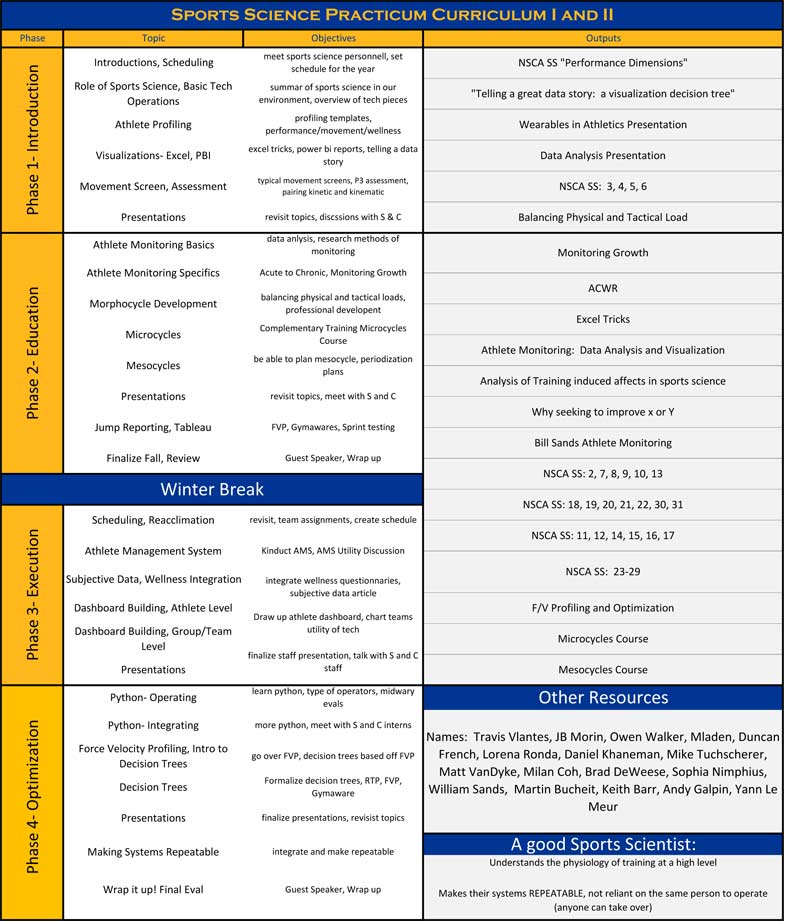
Our other main goal of year one is gaining a greater understanding of what the sport coaches know and don’t know about this department and then educating them. What is sports science? Why is it important to them? How will it help them win more games or matches and keep their student-athletes available to complete?
Our other main goal of year one is gaining a greater understanding of what the sport coaches know and don’t know about the sport science department and then educating them, says @CoachStephMock. Share on XTwo major activities we like to put on for sport coaches in year one are the “Sports Science Playbook” and our “Sports Science Open House.” For our Sports Science Playbook, we like to meet with each coach individually to allow for the most open dialogue possible and invite as many specific questions as they can ask. As for our Sports Science Open House, we like to open our facility to all staffs to give them a hands-on introduction and presentation on the different pieces of technology that their teams will have access to. You can find both materials and presentations here to give you better insight.
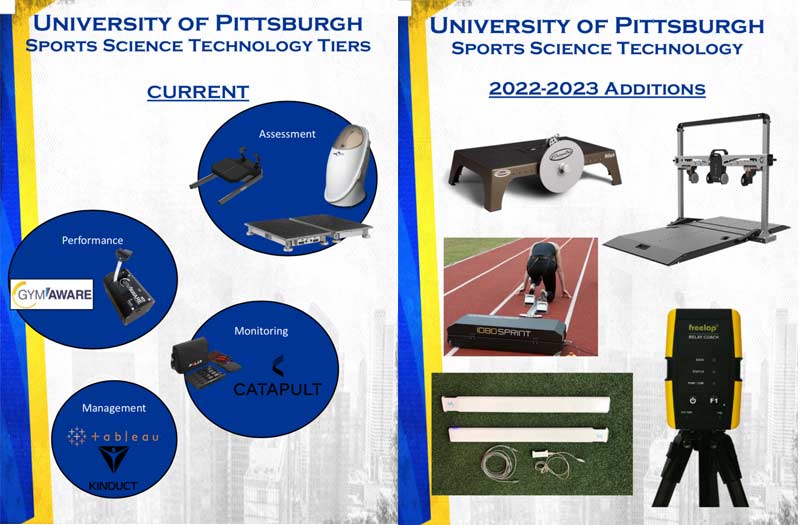
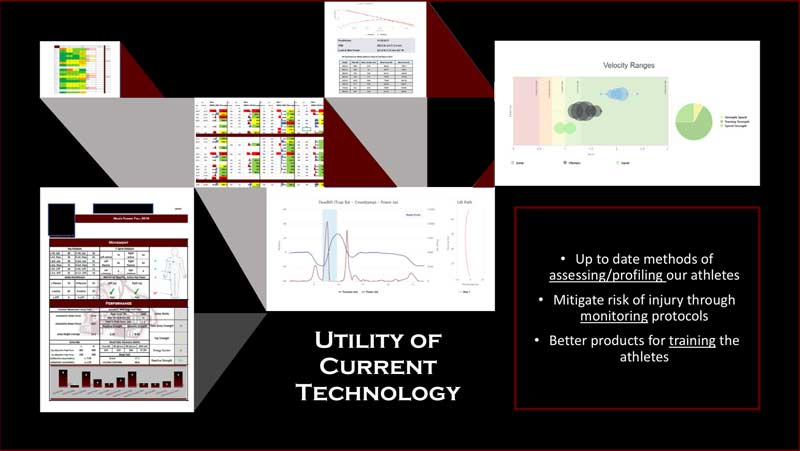
During this first year, it is important to establish a why behind your department. What is sports science? Why is it important for their team? How will it help them win more games or matches?
Year Two: Build the Frame and Installation
In year two, we want to continue to build the framework of our Sports Science Department by adding a new Director of Sports Science role.
Goals/Objectives:
- Hire a Director of Sports Science.
- Evaluate the current setup.
- Establish systems.
- Improve the utilization of AMS.
- Create partnerships to fund master’s students.
We envision that during the first 90 days, the sports scientist initiatives can be assessed for:
- What is working?
- What can be improved?
- What is not working?
Answering these questions should allow us to prioritize where to start with the list of year one goals for the Director of Sports Science.
Establish Systems
First, when establishing systems, it will be important to meet with each sport. The three main questions the Director of Sports Science needs to ask are: what technology is being used, what data is being collected, and what reporting is being done? Doing so allows them to begin immediately addressing the highest priority needs of each sport. By creating solutions to these problems, we can begin to educate coaches or staff on why and how these needs should be addressed.
We establish systems to help paint a clearer picture of athlete availability, athlete status, and training effectiveness. The most efficient way to make an immediate impact is to identify the “lowest-hanging fruit” for each team. By identifying these major gaps or limiters in performance, we can create easy wins and victories within teams.
Operate AMS and Optimize Sports Science Student Experience
As the prime operator for the AMS of all teams, ensuring that data is organized and clean is crucial. Building out dashboards and visualizations will be key for disseminating information and making it actionable. It is imperative to eliminate unnecessary data collection to reduce the noise and maximize efficiency.
Developing sports science students into sound practitioners is an extremely important goal of the department. We can progress these students by developing and cultivating a practicum/curriculum. A key piece to this in year two is identifying what the curriculum is missing and determining solutions to fix that.
We understand that achieving all these goals can be a large feat for one individual and a group of master’s students, but we truly believe that education will be key along the way. When creating a new leadership role, be clear and concise about its goals, not only for the first three months but the entire first year, to allow the framework to hold strong for years to come.
Year Three: Move-In
At Pitt, in year three of our road map, we will move into our new performance facility (Victory Heights), where our new sports science lab and our new weight room will be located.
Goals/Objectives:
- Hire an Assistant Sport Scientist.
- ScD Program for Sports Science created.
- Build a library of one- to three-minute education tutorials.
- Put together a proposal for administration.
When hiring directors and assistants, it is important that the Sports Science Department be well-rounded when it comes to skill sets. We divide our Sports Science Department into these three categories:
- Assessment – force plate, Dari, reporting.
- Monitoring – heart rate, Catapult, data skill set turn around.
- Education.
It is also important that the sport scientists we hire can also be athlete- and coach-facing and not just nerds with high levels of education who can’t speak the language.
With departments growing at a fast rate, it is important to keep the sport coaches and performance staff in the know. With that said, during this particular phase at Pitt, we will begin our one- to three-minute tutorial series “PS3” (Pitt Sports Science Series) and create content to educate on the following areas:
- How do GPS units work?
- Applied practice situations.
- Force plates – RTP
- What is motion capture?
- Feedback loop utilized when collecting data.
- How to run reports.
- Dashboards 101.
- Catapult report – what does this mean?
The year three phase will be when the department truly hits its stride, not only with a bigger staff, but a new lab and facility. Thinking further into the future remains important—this means putting together future job proposals to continue to keep the department moving in a positive direction. At this point and time, the department should be in a place where we have accumulated enough data and projects that we will need a data analyst to come in and organize it all for us.
In year three, the department should be in a place where we’ve accumulated enough data and projects that we’ll need a data analyst to come in and organize it all for us, says @CoachStephMock. Share on XBring It All Home
Hopefully, the example of this road map provides you all with at least one key takeaway. I can in no way take all the credit for all these amazing ideas. I must give thanks to my Associate Head Strength and Conditioning Coach Aaron Duvall; Travis Vlantes, John Wagle, Josh Nelson, Ryan Grubbs, and Rick Franzblau for being mentors and having a large influence on me along with the way; and the University of Pittsburgh for supporting my vision for building out this department. Thank you SimpliFaster for this opportunity and Hail to Pitt!
(Lead photo by Richard C. Lewis/Icon Sportswire).
Since you’re here…
…we have a small favor to ask. More people are reading SimpliFaster than ever, and each week we bring you compelling content from coaches, sport scientists, and physiotherapists who are devoted to building better athletes. Please take a moment to share the articles on social media, engage the authors with questions and comments below, and link to articles when appropriate if you have a blog or participate on forums of related topics. — SF

